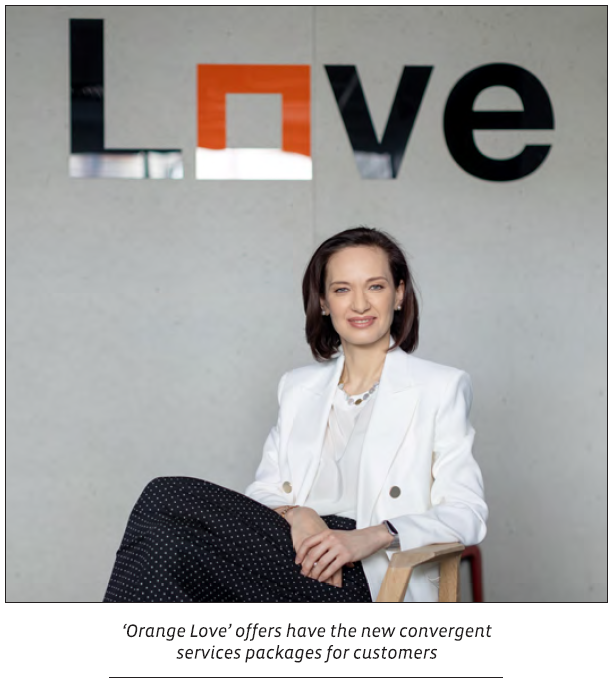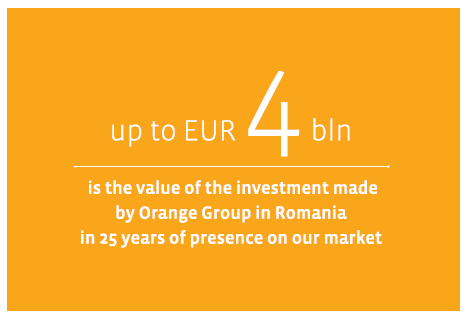The journey of Orange România & Orange Romania Communications that resulted in a unique M&A process on the local telecommunication market. ‘An adventure,’ as described by Liudmila Climoc, the CEO of Orange România, who took the time to walk us through the entire process of rebranding a service provider with focus on customer experience.
By Aurel Constantin
What steps did you take within the first six months after completing the transaction?
Our journey with fixed services operator Orange Romania Communications started on September 30, 2021, and all the steps we have taken together have made this a complex M&A process and a unique one on the local telecommunications market. In our case, the competitor, from which Orange Romania Communications (n.r. former Telekom Romania Communications) has detached, is still on the market. This brought important legal & compliance requirements that made this journey extremely challenging, but also rewarding, considering all the smart & innovative solutions we have found.
We reached the 6-month milestone at the end of March 2022, after a period that brought us closer to our objective — becoming the preferred choice for convergent services in Romania. We started this journey with a focus on customers and teams. We wanted to be transparent and keep our clients informed, and that’s why we launched the hellofix.ro website from day one, to provide answers to the most important questions related to the impact of the transaction among our customers.
At the same time, we focused on bringing employees together, so they could get to know each other while operating as two separate companies. The transition of fixed services operator Orange Romania Communications to the Orange brand was a major project that involved transversally all the functions from the two companies.

Looking back, there were many other operations that required a considerable effort, such as transitioning all internal addresses to the Orange domain, moving the Orange Romania Communications registered office to the address of a local historic monument — The Telephone Palace —or renaming Telekom Romania Communications to Orange Romania Communications.
Our project team had to manage a long list of touchpoints and very busy agendas with hundreds of tasks, but I want to highlight three very complex projects:
The first is the unification of contact channels allowing Orange Romania Communications customers to have access to all main contact points as Orange customers: call center, shops, the orange.ro website, and the social media pages all under the Orange brand. It was a major operational effort to provide a similar experience to Orange Romania Communications and Orange România customers, but we made it happen. The second major process, which I will detail in a moment, was the transfer of Orange Romania Communications customers from the Telekom Romania mobile network to the Orange România mobile network. We are talking about more than 800,000 customers with mobile services associated with fixed-mobile contracts, for whom we sought an innovative telecommunications solution.
The third and ‘final touch’ was the launch of the first joint offer from Orange and Orange Romania Communications, which brings speeds of 1.8 Gpbs for the first time in Romania, along with connectivity in the #1 mobile network, Orange, as well as TV services with access to Orange Sport channels. In the coming months, we will focus on operational excellence and the further alignment of processes, so that Orange Romania Communications customers can receive superior support & network experience. After welcoming Orange Romania Communications as a subsidiary of Orange România, our investment in telecommunications networks will exceed 200 million euros annually, consolidating the investment of up to 4 billion euros that Orange has made in its 25 years of presence on the local market.

You carried out a very large rebranding process in a very short amount of time. What were the biggest challenges in this process?
On September 30, we knew that one of the most important milestones we’d reach together would come after the first 6 months, when we’d have to complete the rebranding process. Rebranding doesn’t just mean changing the logo or the colours, but a series of actions that are all linked to the customer journey and to how customers interact with our company. In this context, all Orange Romania Communications assets had to be readjusted beyond their look & feel in order to come as close as possible to the Orange DNA.
The rebranding meant a great involvement at an organizational level, and now we see it as a remarkable achievement. Here are some key figures, to give you an idea: over 500 web pages redesigned, three mobile applications completely reshaped, and 55 Orange Romania Communications stores rebranded.
Internally, we developed dedicated training sessions for our new Orange Romania Communications colleagues, because the Orange brand is part of our commercial approach, but it influences our culture as well. A significant number of employees attended the brand induction courses, revealing great interest in understanding the values of the Orange brand. It was an immense effort for which I’m grateful.
How have you approached the technical adjustments to the service infrastructure so that customers wouldn’t experience interruptions or changes in their use?
The acquisition of fixed services operator Orange Romania Communications brought several technical challenges. All the steps mentioned above required us to rethink our network and IT solutions. One of the biggest challenges, which brought a remarkable innovation in telecommunications into the limelight, was the transfer of connectivity for mobile customers from Telekom Romania Mobile to the Orange mobile network.
Among the customers who are now part of the Orange group there is a number of clients whose mobile services are associated with fixed-mobile contracts with Orange Romania Communications. On September 30, mobile services for these customers were provided through an MVNO contract with Telekom Romania Mobile —the MVNO being, in short, a ‘network rental’ contract. Following the acquisition, we wanted these customers to have access to the Orange mobile network. But how do you transfer such a large number of customers from one mobile network to another, in the middle of a pandemic, without changing their physical SIM cards so as to avoid a major inflow of customers in stores? The answer came from our technical teams, who created an automated flow that allowed Orange Romania Communications SIMs to be registered in the Orange network without user intervention, maintaining the security standards in telecommunications and the services associated with each SIM card.
How did the Orange and Telekom teams react to the rebranding process?
Through this acquisition, we brought together complementary services, telecommunications infrastructures, and, most importantly, teams. Some of the best telecommunications experts are today under the same roof, but they have different ways of working, cultures, and histories. Aligning all these requires thorough analysis, patience, and the identification of the best and most effective ways of working together. We have built our joint vision and strategic objectives with the contribution of both teams. We found brand induction webinars to be greatly helpful; they were organized by colleagues from the Learning & Development team and attended by thousands of people.
Meanwhile, we’ve been preparing our new home. We are now making the final arrangements in a new office building that will host teams from both companies. It was a demanding, but also exciting 6-month period!
The global telecommunications industry is dominated by consolidation. Why is this happening and what is behind the trend?
The consolidation trend can be observed across several industries, not just telecommunications, because customers want a one-stop shop experience, with more integrated services from a single operator. For example, Orange offers fixed-mobile-TV packages, IT&C solutions for companies and public administrations, as well as financial services. In every European country where the Orange Group operates, the last decade has brought a development of fixed-mobile convergence, determined by the need for simplification and high-quality services. Convergence is the cornerstone of Orange Group’s strategy today, and our European leadership is confirmed by 11.5 million convergent customers. The steps we have made in Romania and the process that’s already well underway in Belgium to acquire Voo are strengthening the Group’s approach. In Romania, Orange has a clear strategy of becoming customers’ preferred choice for convergent services, and the acquisition of the majority stake in Orange Romania Communications shares is a major step in this direction.
How has the local market changed as a result of the takeovers of recent years?
Romania is one of the most competitive markets in the EU, and local customers benefit from the best value for money. The Romanian market has reached its value potential for the most part, so operators are now moving towards convergence, innovation, digital services, and differentiated, high-quality content. 41 percent of Romanian households are already convergent, meaning they are using a mobile service and a fixed service from the same provider, while Orange is present in 1 out of 2 households in Romania. There are several advantages of this growing local convergence trend. Romania joins a select club of countries such as Spain or France, with 3 big players providing fixed-mobile convergent offers. In terms of network development, convergence can maximise synergies between networks, creating better infrastructure & paving the way to future networks with 5G, Open RAN etc. This increases the country’s attractiveness for foreign investment and economic development through digital transformation.
Orange Business Services is a key player on the data center services market in Romania. How has it evolved in recent years and what does the future of this division look like?
Demand for IT&C services increased considerably in 2021 compared to the previous year, with Orange Business Services being a growth engine for Orange România. Togheter with Orange Romania Communications team and ecosystem of partnerships and solutions, Orange Business Services is today one of the most powerful suppliers and integrators of technology in Romania. In addition, it has become a key player on the local data center market, with 5 data centers in Bucharest, Cluj-Napoca, and Brașov, hosting services, virtualization, and strong cyber security skills.
What are the plans for Orange this year?
We will continue expanding the footprint of our convergent offer by aligning and developing the strengths of our mobile and fixed networks. Our main objective is to create a one-stop shop experience that provides full digital services and top-quality content. Having reached many of the planned milestones in the six months that followed the transaction, we are now even more focused on fostering good collaboration between our teams for the benefit of our customers. By operating at the highest standards, we know that we can offer our customers a great experience in the best network.


:quality(80)/business-review.eu/wp-content/uploads/2022/05/interior-2.jpg)

:quality(80)/business-review.eu/wp-content/uploads/2024/07/halmagean-interview-1.jpg)



:quality(80)/business-review.eu/wp-content/uploads/2024/06/22C0420_006.jpg)

:quality(80)/business-review.eu/wp-content/uploads/2024/06/COVER-1-4.jpg)



:quality(50)/business-review.eu/wp-content/uploads/2024/07/nedea-rigo.jpg)
:quality(50)/business-review.eu/wp-content/uploads/2024/07/BAT-interview.jpg)
:quality(50)/business-review.eu/wp-content/uploads/2024/04/Nicolae-Banica.jpg)
:quality(80)/business-review.eu/wp-content/uploads/2024/06/br-june-2.jpg)
:quality(50)/business-review.eu/wp-content/uploads/2024/07/vodafone-RO.jpg)
:quality(50)/business-review.eu/wp-content/uploads/2024/07/BeFunky-collage-37-scaled.jpg)
:quality(50)/business-review.eu/wp-content/uploads/2024/07/04_ThinkPad_T14s_6_Business_Coworking.jpg)